Amazon Machine Learning activity
An activity that gives predictions based on an Amazon Machine Learning model for the AgilePoint NX application. You can also skip steps in a process if the conditions specified in the Amazon Machine Learning model occur.
Amazon Machine Learning analyzes the data to create a predication. For example, you have college enrollment data based on historical data. The college enrollment data contains grade, family income, course, and previous school. Based on the college enrollment data, Amazon Machine Learning can predict whether the candidate qualifies for admission to your school.

Configure the Amazon Machine Learning activity
To configure the Amazon Machine Learning activity, do the procedure in this topic.
Prerequisites
- AgilePoint NX OnDemand (public cloud), or AgilePoint NX PrivateCloud or AgilePoint NX OnPremises v7.0 Software Update 1 or higher.
Good to Know
- To send an e-mail notification, click
Advanced
 >
E-mail Notifications
>
E-mail Notifications  .
. For more information, refer to Configure E-mail Notifications for Any Activity.
- In most text fields, you can use process data variables as an alternative to literal data values.
- You can configure whether this activity waits for other activities before it runs.
For more information, refer to How Do I Configure an Activity to Wait for Other Incoming Activities?
- Some information about third-party integrations is outside the scope of the AgilePoint NX Product Documentation, and it is the responsibility of the vendors who create and maintain these technologies to provide this information. This includes specific business uses cases and examples; explanations for third-party concepts; details about the data models and input and output data formats for third-party technologies; and various types of IDs, URL patterns, connection string formats, and other technical information that is specific to the third-party technologies. For more information, refer to Where Can I Find Information and Examples for Third-Party Integrations?
You can not connect this activity to your process flow. To configure this activity, put it on the process model not connected to any other activities to configure it.
How to Start
- On the Application Explorer screen, do one of these:
- Do one of these:
- Add an activity:
- In the Process Builder, in the Activity Library
open the Machine Learning
 tab.
tab. - On the
Machine Learning
 tab,
drag the Amazon Machine Learning
tab,
drag the Amazon Machine Learning  activity onto your process.
activity onto your process.
- In the Process Builder, in the Activity Library
open the Machine Learning
- Change an activity:
- In your process, double-click your activity.
- Add an activity:
General Configuration
Specifies the basic settings for the Amazon Machine Learning activity.

Fields
| Field Name | Definition |
|---|---|
|
Display Name |
|
|
Description |
|
Amazon Machine Learning Configuration > Request tab
Configures the score models for an activity where the Amazon Machine Learning model runs.
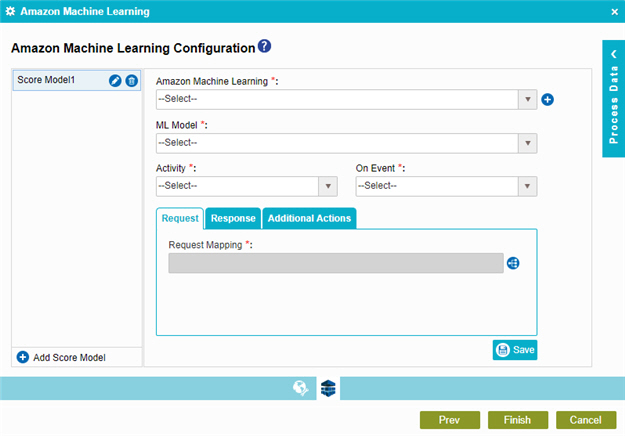
Fields
| Field Name | Definition |
|---|---|
|
Add Score Model |
|
|
Edit |
|
|
Delete |
|
|
Amazon Machine Learning |
|
|
Add Token |
|
ML Model |
|
|
Activity |
|
On Event |
|
|
Request Mapping |
|
|
Save |
|
Amazon Machine Learning Configuration > Response tab
Specifies where to store the response from Amazon Machine Learning.
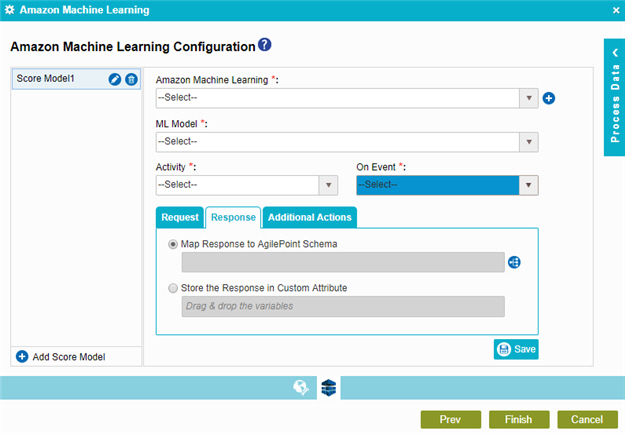
Fields
| Field Name | Definition |
|---|---|
|
Add Score Model |
|
|
Edit |
|
|
Delete |
|
|
Amazon Machine Learning |
|
|
Add Token |
|
ML Model |
|
|
Activity |
|
On Event |
|
Store the Response in Custom Attribute / Map Response to AgilePoint Schema |
|
|
Save |
|
Amazon Machine Learning Configuration > Additional Actions tab
Specifies whether to skip the activities in the AgilePoint process when specified conditions occur.
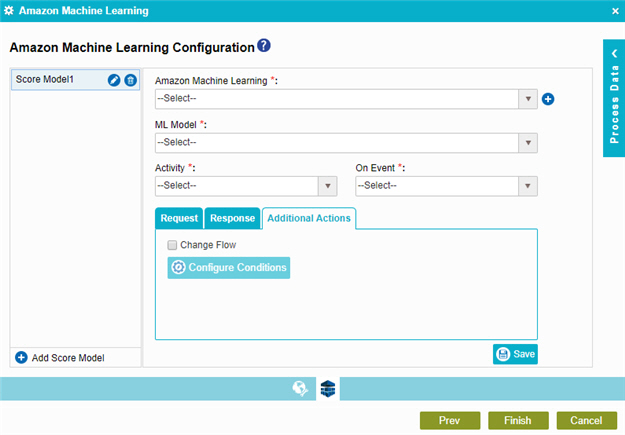
Fields
| Field Name | Definition |
|---|---|
|
Add Score Model |
|
|
Edit |
|
|
Delete |
|
|
Amazon Machine Learning |
|
|
Add Token |
|
ML Model |
|
|
Activity |
|
On Event |
|
Change Flow |
|
Configure Conditions |
|
|
Save |
|
Amazon Machine Learning Configuration > Configure Conditions screen
Specifies the conditions that cause the process to skip activities.
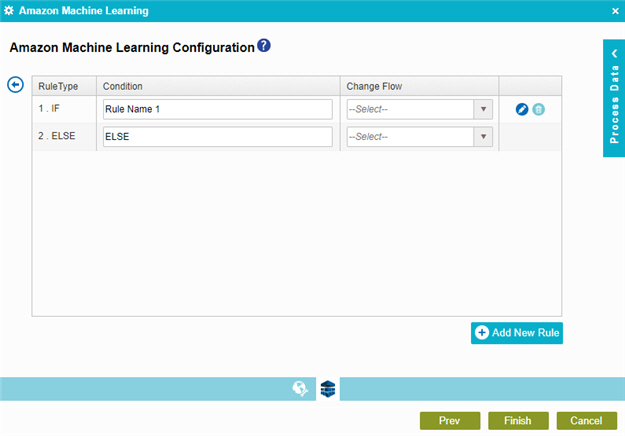
Fields
| Field Name | Definition |
|---|---|
|
Rule Type |
|
Condition |
|
Change Flow |
|
|
Configure Conditions |
|
|
Add New Rule |
|
Amazon Machine Learning Configuration > Condition Builder screen
Creates or changes logical rules. You can put one statement inside another statement to create complex logical expressions.
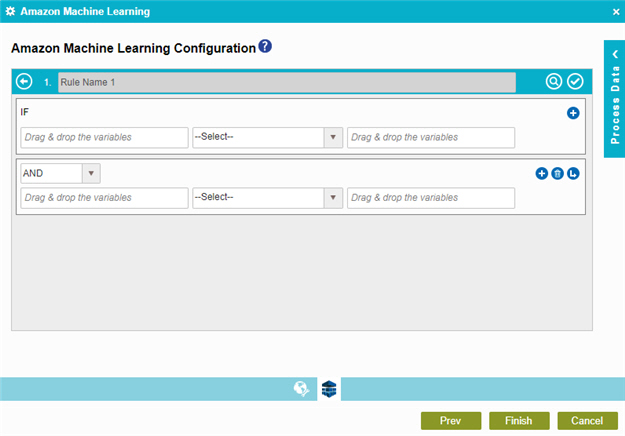
Fields
| Field Name | Definition | ||||||||||
|---|---|---|---|---|---|---|---|---|---|---|---|
|
Condition Name |
|
||||||||||
|
Validate |
|
||||||||||
|
Preview |
|
||||||||||
|
Rule Variable |
|
||||||||||
|
Operator |
|
||||||||||
|
Rule Value |
|
||||||||||
|
Add |
|
||||||||||
|
Subcondition |
|
||||||||||
|
Delete |
|
||||||||||
|
Back |
|







